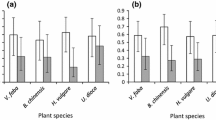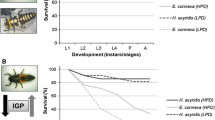Abstract
Intraguild predation (IGP) is a widespread interaction between predatory arthropods, and is influenced by several factors. The harlequin ladybird, Harmonia axyridis (Coleoptera: Coccinellidae), has frequently been reported as an intraguild predator of other Coccinellidae, but little is known about its interactions with other aphidophagous predators, including syrphids. This study investigated the incidence of IGP between H. axyridis and Episyrphus balteatus (Diptera: Syrphidae), the most abundant hoverfly species in Europe and a commercially available aphid biocontrol agent. The influence of size, presence of extraguild prey and habitat complexity were investigated through laboratory experiments in Petri dishes and on potted broad bean plants. In both types of arenas, IGP between H. axyridis and E. balteatus was found to be asymmetric, with the coccinellid in the majority of cases being the intraguild predator. There was a significant effect of size on the frequency of IGP. The efficiency of H. axyridis as an intraguild predator increased with the developmental stage. Early instars of E. balteatus were the most vulnerable to IGP. Pupae of either species were not attacked. In the presence of extraguild prey, the frequency of IGP was substantially reduced. However, IGP still occurred, mainly in combinations of older larvae of H. axyridis with first or second instars of E. balteatus. The size of the arena affected the incidence of IGP in combinations with second instars of E. balteatus, but not in combinations with third instars. Field research is needed to elucidate the ecological relevance of IGP among these predators.


Similar content being viewed by others
References
Adriaens T, San Martin y Gomez G, Maes D (2008) Invasion history, habitat preferences and phenology of the invasive ladybird Harmonia axyridis in Belgium. BioControl 53:69–88
Alhmedi A, Haubruge E, Bodson B, Francis F (2007) Aphidophagous guilds on nettle (Urtica dioica) strips close to fields of green pea, rape and wheat. Insect Sci 14:419–424
Alhmedi A, Haubruge E, Francis F (2010) Intraguild interactions and aphid predators: biological efficiency of Harmonia axyridis and Episyrphus balteatus. J Appl Entomol 134:34–44
Almohamad R, Verheggen FJ, Francis F, Haubruge E (2010) Intraguild interactions between the predatory hoverfly Episyrphus balteatus (Diptera: Syrphidae) and the Asian ladybird, Harmonia axyridis (Coleoptera: Coccinellidae): effect of larval tracks. Eur J Entomol 107:41–45
Altman M, Gill J, McDonald MP (2004) Numerical issues in statistical computing for the social scientist. Wiley, Hoboken
Alyokhin A, Sewell G (2004) Changes in a lady beetle community following the establishment of three alien species. Biol Invasions 6:463–471
Arim M, Marquet PA (2004) Intraguild predation: a widespread interaction related to species biology. Ecol Lett 7:557–564
Berkvens N, Bonte J, Berkvens D, Deforce K, Tirry L, De Clercq P (2008) Pollen as an alternative food for Harmonia axyridis. BioControl 53:201–210
Brown PMJ, Adriaens T, Bathon H, Cuppen J, Goldarazena A, Hagg T, Kenis M, Klausnitzer BEM, Kovar I, Loomans AJM, Majerus MEN, Nedved O, Pedersen J, Rabitsch W, Roy HE, Ternois V, Zakharov IA, Roy DB (2008) Harmonia axyridis in Europe: spread and distribution of a non-native coccinellid. BioControl 53:5–21
Burgio G, Santi F, Maini S (2002) On intra-guild predation and cannibalism in Harmonia axyridis (Pallas) and Adalia bipunctata L. (Coleoptera: Coccinellidae). Biol Control 24:110–116
Chang GC (1996) Comparison of single versus multiple species of generalist predators for biological control. Environ Entomol 25:207–212
Colunga-Garcia M, Gage SH (1998) Arrival, establishment, and habitat use of the multicolored Asian lady beetle (Coleoptera: Coccinellidae) in a Michigan landscape. Environ Entomol 27:1574–1580
Cottrell TE (2005) Predation and cannibalism of lady beetle eggs by adult lady beetles. Biol Control 34:159–164
Cottrell TE, Yeargan KV (1998) Intraguild predation between an introduced lady beetle, Harmonia axyridis (Coleoptera: Coccinellidae), and a native lady beetle, Coleomegilla maculata (Coleoptera: Coccinellidae). J Kans Entomol Soc 71:159–163
Coutanceau JP (2006) Harmonia axyridis (Pallas, 1773) : une coccinelle asiatique introduite, acclimatée et en extension en France. Bull Soc Entomol France 111:395–401
Day WH, Prokrym DR, Ellis DR, Chianese RJ (1994) The known distribution of the predator Propylea quattuordecimpunctata (Coleoptera, Coccinellidae) in the United States, and thoughts on the origin of this species and 5 other exotic lady beetles in eastern North-America. Entomol News 105:244–256
De Clercq P, Peeters I, Vergrauwe G, Thas O (2003) Interaction between Podisus maculiventris and Harmonia axyridis, two predators used in augmentative biological control in greenhouse crops. BioControl 48:39–55
Denno RF, Finke DL (2006) Multiple predator interactions and food-web connectance: implications for biological control. In: Brodeur J, Boivin G (eds) Trophic and guild interactions in biological control. Springer, Dordrecht, pp 45–70
Félix S, Soares AO (2004) Intraguild predation between the aphidophagous ladybird beetles Harmonia axyridis and Coccinella undecimpunctata (Coleoptera: Coccinellidae): the role of body weight. Eur J Entomol 101:237–242
Frechette B, Rojo S, Alomar O, Lucas E (2007) Intraguild predation between syrphids and mirids: who is the prey? Who is the predator? BioControl 52:175–191
Gardiner MM, Landis DA (2007) Impact of intraguild predation by adult Harmonia axyridis (Coleoptera: Coccinellidae) on Aphis glycines (Hemiptera: Aphididae) biological control in cage studies. Biol Control 40:386–395
Gordon RD (1985) The Coccinellidae (Coleoptera) of America north of Mexico. J NY Entomol Soc 93:1–912
Hindayana D, Meyhofer R, Scholz D, Poehling HM (2001) Intraguild predation among the hoverfly Episyrphus balteatus de Geer (Diptera: Syrphidae) and other aphidophagous predators. Biol Control 20:236–246
Hodek I, Honek A (1996) Ecology of Coccinellidae. Kluwer, Dordrecht
Hoogendoorn M, Heimpel GE (2004) Competitive interactions between an exotic and a native ladybeetle: a field cage study. Entomol Exp Appl 111:19–28
Janssen A, Montserrat M, HilleRisLambers R, de Roos AM, Pallini A, Sabelis MW (2006) Intraguild predation usually does not disrupt biological control. In: Brodeur J, Boivin G (eds) Trophic and guild interactions in biological control. Springer, Dordrecht, pp 21–40
Janssen A, Sabelis MW, Magalhaes S, Montserrat M, Van der Hammen T (2007) Habitat structure affects intraguild predation. Ecology 88:2713–2719
Kajita Y, Takano F, Yasuda H, Agarwala BK (2000) Effects of indigenous ladybird species (Coleoptera: Coccinellidae) on the survival of an exotic species in relation to prey abundance. Appl Entomol Zool 35:473–479
Kajita Y, Takano F, Yasuda H, Evans EW (2006) Interactions between introduced and native predatory ladybirds (Coleoptera, Coccinellidae): factors influencing the success of species introductions. Ecol Entomol 31:58–67
Koch RL (2003) The multicoloured Asian lady beetle, Harmonia axyridis: a review of its biology, uses in biological control, and non-target impacts. J Insect Sci 3:1–16
Koch RL, Venette RC, Hutchison WD (2006) Invasions by Harmonia axyridis (Pallas) (Coleoptera: Coccinellidae) in the Western Hemisphere: implications for South America. Neotrop Entomol 35:421–434
Levin SA (1992) The problem of pattern and scale in ecology. Ecology 73:1943–1967
Lombaert E, Guillemaud T, Cornuet JM, Malausa T, Facon B, Estoup A (2010) Bridgehead effect in the worldwide invasion of the biocontrol harlequin ladybird. Plos One 5: Artn E9743. doi:10.1371/Journal.Pone.0009743
Lucas E (2005) Intraguild predation among aphidophagous predators. Eur J Entomol 102:351–363
Lucas E, Coderre D, Brodeur J (1998) Intraguild predation among aphid predators: characterization and influence of extraguild prey density. Ecology 79:1084–1092
Majerus M, Strawson V, Roy H (2006) The potential impacts of the arrival of the harlequin ladybird, Harmonia axyridis (Pallas) (Coleoptera: Coccinellidae), in Britain. Ecol Entomol 31:207–215
McCornack BP, Koch RL, Ragsdale DW (2007) A simple method for in-field sex determination of the multicolored Asian lady beetle Harmonia axyridis. J Insect Sci 7:1–12
McCullagh P, Nelder J (1989) Generalized linear models. Chapman and Hall, London
Michaud JP (2002) Invasion of the Florida citrus ecosystem by Harmonia axyridis (Coleoptera: Coccinellidae) and asymmetric competition with a native species, Cycloneda sanguinea. Environ Entomol 31:827–835
Michaud JP, Grant AK (2003) Intraguild predation among ladybeetles and a green lacewing: do the larval spines of Curinus coeruleus (Coleoptera: Coccinellidae) serve a defensive function? Bull Entomol Res 93:499–505
Obrycki JJ, Giles KL, Ormord AM (1998) Interactions between an introduced and indigenous coccinellid species at different prey densities. Oecologia 117:279–285
Pell JK, Baverstock J, Roy HE, Ware RL, Majerus MEN (2008) Intraguild predation involving Harmonia axyridis: a review of current knowledge and future perspectives. BioControl 53:147–168
Pervez A, Omkar (2006) Ecology and biological control application of multicoloured Asian ladybird, Harmonia axyridis: a review. Biocontrol Sci Technol 16:111–128
Phoofolo MW, Obrycki JJ (1998) Potential for intraguild predation and competition among predatory Coccinellidae and Chrysopidae. Entomol Exp Appl 89:47–55
Polis GA, Myers CA, Holt RD (1989) The ecology and evolution of intraguild predation: potential competitors that eat each other. Annu Rev Ecol Syst 20:297–330
Putra NS, Yasuda H, Sato S (2009) Oviposition preference of two hoverfly species in response to risk of intraguild predation. Appl Entomol Zool 44:29–36
Sadeghi H, Gilbert F (2000) Aphid suitability and its relationship to oviposition preference in predatory hoverflies. J Anim Ecol 69:771–784
Sato S, Dixon AFG (2004) Effect of intraguild predation on the survival and development of three species of aphidophagous ladybirds: consequences for invasive species. Agric Forest Entomol 6:21–24
Sato S, Dixon AFG, Yasuda H (2003) Effect of emigration on cannibalism and intraguild predation in aphidophagous ladybirds. Ecol Entomol 28:628–633
Sengonca C, Frings B (1985) Interference and competitive behavior of the aphid predators, Chrysoperla carnea and Coccinella septempunctata in the laboratory. Entomophaga 30:245–251
Shellhorn NA, Andow DA (1999) Mortality of coccinellid (Coleoptera: Coccinellidae) larvae and pupae when prey become scarce. Environ Entomol 28:1092–1100
Snyder WE, Ives AR (2003) Interactions between specialist and generalist natural enemies: parasitoids, predators, and pea aphid biocontrol. Ecology 84:91–107
SPSS Inc. (2006) SPSS base user’s guide. SPSS Inc., Chicago
Stubbs AE, Falk SJ (2002) British hoverflies: an illustrated identification guide. British Entomological and Natural History Society, Reading
Tenhumberg B (1995) Estimating predatory efficiency of Episyrphus balteatus (Diptera, Syrphidae) in cereal fields. Environ Entomol 24:687–691
Tenhumberg B, Poehling HM (1995) Syrphids as natural enemies of cereal aphids in Germany: aspects of their biology and efficacy in different years and regions. Agric Ecosyst Environ 52:39–43
Verlinden L, Decleer K (1987) The hoverflies (Diptera, Syrphidae) of Belgium and their faunistics: frequency, distribution, phenology. Koninklijk Belgisch Instituut voor Natuurwetenschappen, Brussel
Ware RL, Majerus MEN (2008) Intraguild predation of immature stages of British and Japanese coccinellids by the invasive ladybird Harmonia axyridis. BioControl 53:169–188
Yasuda H, Kikuchi T, Kindlmann P, Sato S (2001) Relationships between attack and escape rates, cannibalism, and intraguild predation in larvae of two predatory ladybirds. J Insect Behav 14:373–384
Yasuda H, Evans EW, Kajita Y, Urakawa K, Takizawa T (2004) Asymmetric larval interactions between introduced and indigenous ladybirds in North America. Oecologia 141:722–731
Acknowledgments
This study was supported by a grant from the Research Foundation—Flanders (FWO Vlaanderen) to Brecht Ingels. We are grateful to Nick Berkvens and Dirk Berkvens for their help with the statistical analyses. We also thank two anonymous reviewers and the associate editor for their helpful comments and suggestions, which greatly improved this manuscript.
Author information
Authors and Affiliations
Corresponding author
Additional information
Handling Editor: Arne Janssen
Rights and permissions
About this article
Cite this article
Ingels, B., De Clercq, P. Effect of size, extraguild prey and habitat complexity on intraguild interactions: a case study with the invasive ladybird Harmonia axyridis and the hoverfly Episyrphus balteatus . BioControl 56, 871–882 (2011). https://doi.org/10.1007/s10526-011-9363-9
Received:
Accepted:
Published:
Issue Date:
DOI: https://doi.org/10.1007/s10526-011-9363-9




